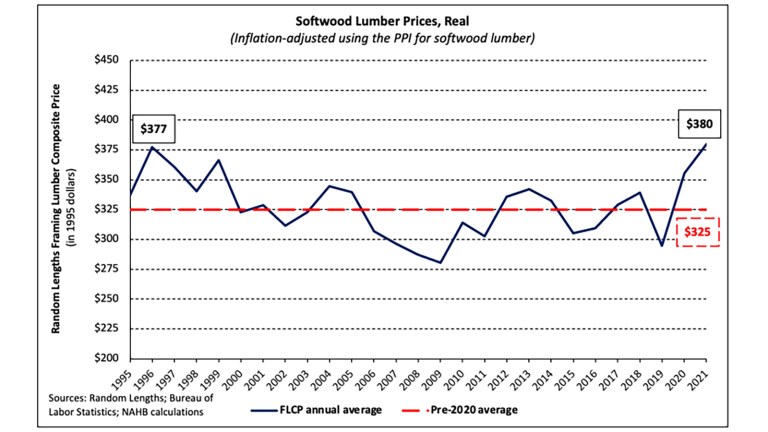Inflation Adjusted Lumber Market Still Hit Records in 20-21
Originally Published by: NAHB — February 4, 2022
SBCA appreciates your input; please email us if you have any comments or corrections to this article.
The price data for softwood lumber for framing is generally quoted using the Random Lengths Framing Lumber Composite Price (FLCP) or lumber futures price — neither of which adjusts for inflation. Although the historical price differences are smaller in real terms than nominal, the inflation-adjusted lumber prices set records in both 2020 and 2021.
Lumber prices began soaring shortly after the pandemic hit the United States in early 2020. The FLCP, an industry benchmark, increased roughly 175% between April and September, and set all-time highs each of the final nine weeks over that span. In May 2021, the FLCP topped $1,500 per thousand board feet (mbf) — nearly three times the pre-pandemic record. The price of framing lumber averaged roughly $550 in 2020 and nearly $850 in 2021, each a new annual record.

The chart below shows that, even after adjusting for inflation, the average price of framing lumber in 2021 was 17% above its 25-year average and broke the prior record set in 1996. The FLCP series shown has been adjusted using the U.S. Bureau of Labor Statistics Producer Price Index (PPI) for softwood lumber.
Because the PPI for softwood lumber is derived from component series, the nominal prices may also be deflated by the PPI for softwood cut stock and dimension. Doing so highlights the fact that prices in both 2020 and 2021 were unprecedented. The average real price of lumber exceeded the prior record by 4.3% in 2020 and 2.4% in 2021. Over that 24-month span, real prices were 37% above the historical average.

Overall, the Random Lengths Framing Lumber Composite Price has more than tripled since late August 2021, and front-month lumber futures have roughly doubled. Although mill prices have eased slightly in the past couple of weeks, it will take a sustained downward trend for the typical builder to get any relief. Because of the mechanics of the lumber supply chain, builders and home owners are unfortunately the last to see their costs go down.
Unfortunately, increases in output of the U.S. softwood lumber industry over the past 18 months have been negligible even as housing starts have soared. As housing demand remains strong, the only solution to rising prices is increased sawmill output.
David Logan, NAHB director of tax and trade policy analysis, provides more in this Eye on Housing post.
